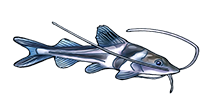Reference: http://meriva.pucrs.br/dspace/handle/10923/5354; complete PDF HERE.
This is dated and some conclusions were never validated (e.g., transferring and one species of to ), but it has photos of some Bunocephalus not otherwise easily found.Cardoso wrote:ABSTRACT
With base on the analysis morphological of 153 characteres and 53 taxa of Aspredinidae are proposed the following results: a) and as monophyletic groups and their interrelations resolved b) eight new species of aspredinids, being that five of them already mentioned by Friel (Acanthobunocephalus sp. nov. 1., Acanthobunocephalus sp. nov. 2., Acanthobunocephalus “l” sp. nov., Amaralia sp. nov. and Ernstichthys sp. nov. ) and three discoveries during the development of this study (Acanthobunocephalus sp. nov. 3., Acanthobunocephalus sp. nov. 4 and Bunocephalus sp. nov. ); c) reallocation of some species of Bunocephalus (B. amazonicus, B. bifidus, B. iheringii, B. quadriradiatus, B. rugosus) in Acanthobunocephalus; d) Bunocephalus aloikae as a species valid and not as synonym of Bunocephalus amaurus; e) key for species from Acanthobunocephalus and Bunocephalus; f) a new classification for Aspredinidae; and g) the corroboration of the hypothesis that Aspredinidae is sister to the Asian Sisoroidea (Amblycipitidae, Akysidae, Sisoridae, and Erethistidae) as proposed by de Pinna, Britto and Diogo Vandewalle & Chardon, and not to the Doradoidea, as suggested by Friel and Sullivan, Lundberg & Hardman.
RESUMO
Com base na análise morfológica de 153 caracteres de 53 táxons de Aspredinidae são propostos os seguintes resultados: a) Acanthobunocephalus e Bunocephalus como grupos monofiléticos e com suas inter-relações resolvidas; b) oito espécies novas de aspredinídeos, sendo que cinco delas já mencionadas por Friel (Acanthobunocephalus sp. nov. 1., Acanthobunocephalus sp. nov. 2., Acanthobunocephalus “l” sp. nov., Amaralia sp. nov. e Ernstichthys sp. nov. ) e três descobertas durante o desenvolvimento deste estudo (Acanthobunocephalus sp. nov. 3., Acanthobunocephalus sp. nov. 4 e Bunocephalus sp. nov. ); c) transferência de algumas espécies de Bunocephalus (B. amazonicus, B. bifidus, B. iheringii, B. quadriradiatus e B. rugosus) para Acanthobunocephalus; d) Bunocephalus aloikae como uma espécie válida e não como sinônimo de Bunocephalus amaurus; e) chave para as espécies de Acanthobunocephalus e Bunocephalus; e) uma nova classificação para Aspredinidae; e f) corroboração da hipótese de que Aspredinidae é grupo irmão do clado asiático Sisoroidea (Amblycipitidae, Akysidae, Sisoridae e Erethistidae), como proposto por de Pinna, Britto e Diogo, Vandewalle & Chardon, e não de Doradoidea como sugerido por Friel e Sullivan, Lundberg & Hardman.
Also, the keys for these fish were extracted and posted here: Cardoso's (2008) key to the genera Bunocephalus, Pseudobunocephalus, and Acanthobunocephalus.



























































/g/s/1.jpg)
/g/s/1.jpg)















